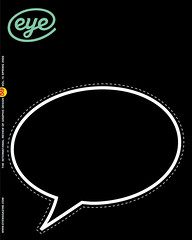Spring 2006
Decorating the screen
Letter from Sean Capone
I write with high praise for the Winter 2005 issue of Eye (no. 58 vol. 15) and ‘The Decriminalisation of Ornament’.It is with keen interest that I have followed the revitalisation of decorational and ornamental design within digital design media. Much of the work may indeed be little more than hyper-stylised posturing, signalling a swing of the historic ‘taste’ pendulum toward an anti-modern baroque decadent fantasy. However, designers today face similar issues and dilemmas to those of the mid- to late-nineteenth century, who, confronted with new means of production and mass-consumer technologies, attempted to reconcile issues of craft and design with a social programme that inspired a sense of meaning and communication.
Today, however, the ‘screen’ has absorbed both the methods of production and, more importantly, their means of distribution and consumption. By this I mean that the computer and video screen have become both the designers’ workshop and the medium through which the designers’ products are now encountered: mobile phone ringtones, desktops, Web interfaces, video projections, showrooms, motion graphics and large-scale architectural video billboards. Video design has expanded beyond its own surface into the disciplines of interior design, environmental graphics, interactive displays, mobile technology and – soon – into the field of textile and fashion with wearable technology and optical fibres. The ‘object’ – while evidently not replaced – now competes in visual culture with these surfaces of ‘communication’, which are transient.
The trend (more, I think, of a recovery) of ornamentation and pattern finds its way into these ‘new media’ design practices as well, with the added kick of an artform unique to the ‘screen’ in all its forms: animation. The creation of patterns and nature-inspired ornamentation is given a new twist as designers grapple with how to express their composition and development over time, and how decorative design is applied functionally as a narrative, communicative or decorational device in its service to the project, from film titles to screensavers to ambient club projection visuals.
This process is given added dimension by the computational nature of CG animation, which allows for the simulation of the dynamic, generative properties of nature, and which now finds its way almost casually into ‘new’ architecture and graphic, textile and animation design. While these techniques are borne of technology and nouveau futurism, similar ideas find expression even in the nineteenth-century anxieties of Gottfried Semper and Owen Jones, who called for the ‘new style’ to be ‘not imitative of nature but to apply nature’s inherent laws’. (So let’s put William Morris and Karim Rashid into the ring together and see how they compare and contrast.)
Nineteenth-century designers and educators were most anxious about the lack of ‘style’ of their period and the threats presented by industrialisation on one hand and reactionary imperialism on the other. Both John Ruskin’s praise and Adolf Loos’s admonitions of the ‘decorative’ must be put into context of their somewhat racist, European attitudes toward the high achievements of so-called primitive art and ornament, which was under discussion so heavily in the arts culture of the period.
New York
First published in Eye no. 59 vol. 15 2006
Eye is the world’s most beautiful and collectable graphic design journal, published quarterly for professional designers, students and anyone interested in critical, informed writing about graphic design and visual culture. It is available from all good design bookshops and online at the Eye shop, where you can buy subscriptions, back issues and single copies of the latest issue. You can also browse visual samples of recent issues at Eye before You Buy.

